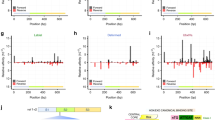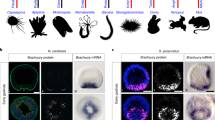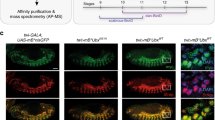Key Points
-
Within Hox gene clusters are loci that encode microRNAs (miRNAs). These include: miR-10, found throughout Bilateria; miR-196, found in vertebrates; and miR-iab4, found in insects.
-
Hox miRNAs preferentially target the mRNA of Hox transcription factors, with a strong propensity to target those from loci situated on the 3′ side of each Hox miRNA locus.
-
These targeting preferences suggest that Hox miRNAs help repress more anterior programmes, thereby reinforcing posterior prevalence, which is the hierarchical control of posterior over anterior Hox gene function.
Abstract
Homeobox (Hox) transcription factors confer anterior–posterior (AP) axial coordinates to vertebrate embryos. Hox genes are found in clusters that also contain genes for microRNAs (miRNAs). Our analysis of predicted miRNA targets indicates that Hox cluster-embedded miRNAs preferentially target Hox mRNAs. Moreover, the presumed Hox target genes are predominantly situated on the 3′ side of each Hox miRNA locus. These results suggest that Hox miRNAs help repress more anterior programmes, thereby reinforcing posterior prevalence, which is the hierarchical dominance of posterior over anterior Hox gene function that is observed in bilaterians. In this way, miRNA-mediated regulation seems to recapitulate interactions at other levels of gene expression, some more ancestral, within a network under stabilizing selection.
This is a preview of subscription content, access via your institution
Access options
Subscribe to this journal
Receive 12 print issues and online access
$189.00 per year
only $15.75 per issue
Buy this article
- Purchase on Springer Link
- Instant access to full article PDF
Prices may be subject to local taxes which are calculated during checkout

Similar content being viewed by others
References
Duboule, D. The rise and fall of Hox gene clusters. Development 134, 2549–2560 (2007). This paper presents a synthesis of the current understanding of the structure, and the developmental and evolutionary significance, of the organization of the Hox clusters.
Krumlauf, R. Hox genes in vertebrate development. Cell 78, 191–201 (1994).
Nei, M. The new mutation theory of phenotypic evolution. Proc. Natl Acad. Sci. USA 104, 12235–12242 (2007).
Cameron, R. A. et al. Unusual gene order and organization of the sea urchin hox cluster. J. Exp. Zool. B Mol. Dev. Evol. 306, 45–58 (2006).
Spagnuolo, A. et al. Unusual number and genomic organization of Hox genes in the tunicate Ciona intestinalis. Gene 309, 71–79 (2003).
Seo, H. C. et al. Hox cluster disintegration with persistent anteroposterior order of expression in Oikopleura dioica. Nature 431, 67–71 (2004).
Shubin, N., Tabin, C. & Carroll, S. Fossils, genes and the evolution of animal limbs. Nature 388, 639–648 (1997).
Spitz, F. et al. Large scale transgenic and cluster deletion analysis of the HoxD complex separate an ancestral regulatory module from evolutionary innovations. Genes Dev. 15, 2209–2214 (2001).
Chourrout, D. et al. Minimal ProtoHox cluster inferred from bilaterian and cnidarian Hox complements. Nature 442, 684–687 (2006).
Garcia-Fernandez, J. & Holland, P. W. Archetypal organization of the amphioxus Hox gene cluster. Nature 370, 563–566 (1994).
Powers, T. P. & Amemiya, C. T. Evidence for a Hox14 paralog group in vertebrates. Curr. Biol. 14, R183–R184 (2004).
Morata, G. Homeotic genes of Drosophila. Curr. Opin. Genet. Dev. 3, 606–614 (1993).
Duboule, D. The vertebrate limb: a model system to study the Hox/HOM gene network during development and evolution. Bioessays 14, 375–384 (1992).
Maconochie, M., Nonchev, S., Morrison, A. & Krumlauf, R. Paralogous Hox genes: function and regulation. Annu. Rev. Genet. 30, 529–556 (1996).
Chen, F. & Capecchi, M. R. Targeted mutations in hoxa-9 and hoxb-9 reveal synergistic interactions. Dev. Biol. 181, 186–196 (1997).
Krumlauf, R. Mouse Hox genetic functions. Curr. Opin. Genet. Dev. 3, 621–625 (1993).
Heard, E. & Bickmore, W. The ins and outs of gene regulation and chromosome territory organisation. Curr. Opin. Cell Biol. 19, 311–316 (2007).
Deschamps, J. Ancestral and recently recruited global control of the Hox genes in development. Curr. Opin. Genet. Dev. 17, 422–427 (2007).
Nelson, C. E. et al. Analysis of Hox gene expression in the chick limb bud. Development 122, 1449–1466 (1996).
Brend, T., Gilthorpe, J., Summerbell, D. & Rigby, P. W. Multiple levels of transcriptional and post-transcriptional regulation are required to define the domain of Hoxb4 expression. Development 130, 2717–2728 (2003).
Bartel, D. P. MicroRNAs: genomics, biogenesis, mechanism, and function. Cell 116, 281–297 (2004).
Lewis, B. P., Shih, I. H., Jones-Rhoades, M. W., Bartel, D. P. & Burge, C. B. Prediction of mammalian microRNA targets. Cell 115, 787–798 (2003).
Lewis, B. P., Burge, C. B. & Bartel, D. P. Conserved seed pairing, often flanked by adenosines, indicates that thousands of human genes are microRNA targets. Cell 120, 15–20 (2005). References 22 and 23 use comparative sequence analyses to develop seed-based target-prediction methods, uncover key features of mammalian miRNA-target recognition and reveal the widespread scope of targeting in vertebrates.
Brennecke, J., Stark, A., Russell, R. B. & Cohen, S. M. Principles of microRNA-target recognition. PLoS Biol. 3, e85 (2005). This paper uses comparative sequence analyses and reporter assays to reveal widespread targeting and important features of target recognition in flies.
Krek, A. et al. Combinatorial microRNA target predictions. Nature Genet. 37, 495–500 (2005).
Yekta, S., Shih, I. H. & Bartel, D. P. MicroRNA-directed cleavage of HOXB8 mRNA. Science 304, 594–596 (2004).
Mansfield, J. H. et al. MicroRNA-responsive 'sensor' transgenes uncover Hox-like and other developmentally regulated patterns of vertebrate microRNA expression. Nature Genet. 36, 1079–1083 (2004).
Hornstein, E. et al. The microRNA miR-196 acts upstream of Hoxb8 and Shh in limb development. Nature 438, 671–674 (2005).
Ma, L., Teruya-Feldstein, J. & Weinberg, R. A. Tumour invasion and metastasis initiated by microRNA-10b in breast cancer. Nature 449, 682–688 (2007).
Woltering, J. M. & Durston, A. J. miR-10 represses HoxB1a and HoxB3a in zebrafish. PLoS ONE 3, e1396 (2008).
Bender, W. MicroRNAs in the Drosophila Bithorax complex. Genes Dev. 22, 14–19 (2008).
Ronshaugen, M., Biemar, F., Piel, J., Levine, M. & Lai, E. C. The Drosophila microRNA iab-4 causes a dominant homeotic transformation of halteres to wings. Genes Dev. 19, 2947–2952 (2005).
Ruby, J. G. et al. Evolution, biogenesis, expression, and target predictions of a substantially expanded set of Drosophila microRNAs. Genome Res. 17, 1850–1864 (2007).
Tyler, D. M. et al. Functionally distinct regulatory RNAs generated by bidirectional transcription and processing of microRNA loci. Genes Dev. 22, 26–36 (2008).
Grimson, A. et al. MicroRNA targeting specificity in mammals: determinants beyond seed pairing. Mol. Cell 27, 91–105 (2007).
Krutzfeldt, J. et al. Silencing of microRNAs in vivo with 'antagomirs'. Nature 438, 685–689 (2005).
Farh, K. K. et al. The widespread impact of mammalian microRNAs on mRNA repression and evolution. Science 310, 1817–1821 (2005).
Lim, L. P. et al. Microarray analysis shows that some microRNAs downregulate large numbers of target mRNAs. Nature 433, 769–773 (2005).
Giraldez, A. J. et al. Zebrafish miR-430 promotes deadenylation and clearance of maternal mRNAs. Science 312, 75–79 (2006).
Wienholds, E. et al. MicroRNA expression in zebrafish embryonic development. Science 309, 310–311 (2005).
Kloosterman, W. P., Wienholds, E., de Bruijn, E., Kauppinen, S. & Plasterk, R. H. In situ detection of miRNAs in animal embryos using LNA-modified oligonucleotide probes. Nature Methods 3, 27–29 (2006).
Lagos-Quintana, M., Rauhut, R., Lendeckel, W. & Tuschl, T. Identification of novel genes coding for small expressed RNAs. Science 294, 853–858 (2001).
Lau, N. C., Lim, L. P., Weinstein, E. G. & Bartel, D. P. An abundant class of tiny RNAs with probable regulatory roles in Caenorhabditis elegans. Science 294, 858–862 (2001).
Palakodeti, D., Smielewska, M. & Graveley, B. R. MicroRNAs from the planarian Schmidtea mediterranea, a model system for stem cell biology. RNA 12, 1640–1649 (2006).
Sempere, L. F., Cole, C. N., McPeek, M. A. & Peterson, K. J. The phylogenetic distribution of metazoan microRNAs: insights into evolutionary complexity and constraint. J. Exp. Zool. B Mol. Dev. Evol. 306, 575–588 (2006).
Stark, A. et al. Systematic discovery and characterization of fly microRNAs using 12 Drosophila genomes. Genome Res. 17, 1865–1879 (2007).
Lagos-Quintana, M., Rauhut, R., Meyer, J., Borkhardt, A. & Tuschl, T. New microRNAs from mouse and human. RNA 9, 175–179 (2003).
Stark, A. et al. A single Hox locus in Drosophila produces functional microRNAs from opposite DNA strands. Genes Dev. 22, 8–13 (2008).
Duboule, D. & Morata, G. Colinearity and functional hierarchy among genes of the homeotic complexes. Trends Genet. 10, 358–364 (1994). This paper develops the concept of posterior prevalence between genes of the Hox clusters.
Struhl, G. Role of the esc+ gene product in ensuring the selective expression of segment-specific homeotic genes in Drosophila. J. Embryol. Exp. Morphol. 76, 297–331 (1983). This paper is the original source for the concept of hierarchical activity among Hox genes, which was deduced from classical genetics experiments in flies.
Gibson, G. & Gehring, W. Head and thoracic transformations caused by ectopic expression of Antennapedia during Drosophila development. Development 102, 657–675 (1988).
Lufkin, T. et al. Homeotic transformation of the occipital bones of the skull by ectopic expression of a homeobox gene. Nature 359, 835–841 (1992).
Pollock, R. A., Sreenath, T., Ngo, L. & Bieberich, C. J. Gain of function mutations for paralogous Hox genes: implications for the evolution of Hox gene function. Proc. Natl Acad. Sci. USA 92, 4492–4496 (1995).
Burglin, T. R. & Ruvkun, G. The Caenorhabditis elegans homeobox gene cluster. Curr. Opin. Genet. Dev. 3, 615–620 (1993).
Martindale, M. Q. The evolution of metazoan axial properties. Nature Rev. Genet. 6, 917–927 (2005).
Davis, G. K. & Patel, N. H. The origin and evolution of segmentation. Trends Cell Biol. 9, M68–M72 (1999).
Waskiewicz, A. J., Rikhof, H. A. & Moens, C. B. Eliminating zebrafish pbx proteins reveals a hindbrain ground state. Dev. Cell 3, 723–733 (2002).
Williams, M. E., Lehoczky, J. A. & Innis, J. W. A group 13 homeodomain is neither necessary nor sufficient for posterior prevalence in the mouse limb. Dev. Biol. 297, 493–507 (2006).
Bartel, D. P. & Chen, C. Z. Micromanagers of gene expression: the potentially widespread influence of metazoan microRNAs. Nature Rev. Genet. 5, 396–400 (2004).
Acknowledgements
We thank laboratory members and collegues for helpful discussions. Supported by grants from the National Institutes of Health.
Author information
Authors and Affiliations
Corresponding author
Related links
Related links
FURTHER INFORMATION
Glossary
- Bilateria
-
Members of the animal clade that have bilateral symmetry — the property of having two similar sides, with definite upper and lower surfaces, and anterior and posterior ends. Bilaterians include chordates, arthropods, nematodes, annelids and molluscs, among other groups.
- Non-synonymous mutation
-
A change in nucleotide sequence that alters the encoded amino acid.
- Paralogous
-
The homology between two genomic segments in the same organism that arose from a duplication event.
- Neofunctionalization
-
The process whereby a pair of duplicated genes becomes permanently preserved as one copy acquires mutations, conferring a new function.
- Rhombomere
-
Each of seven neuroepithelial segments found in the embryonic hindbrain that adopt distinct molecular and cellular properties, restrictions in cell mixing, and ordered domains of gene expression.
Rights and permissions
About this article
Cite this article
Yekta, S., Tabin, C. & Bartel, D. MicroRNAs in the Hox network: an apparent link to posterior prevalence. Nat Rev Genet 9, 789–796 (2008). https://doi.org/10.1038/nrg2400
Issue Date:
DOI: https://doi.org/10.1038/nrg2400
This article is cited by
-
Mitochondrially mediated RNA interference, a retrograde signaling system affecting nuclear gene expression
Heredity (2023)
-
Integrated computational analysis reveals HOX genes cluster as oncogenic drivers in head and neck squamous cell carcinoma
Scientific Reports (2022)
-
HOX gene cluster (de)regulation in brain: from neurodevelopment to malignant glial tumours
Cellular and Molecular Life Sciences (2020)
-
Small RNA expression from viruses, bacteria and human miRNAs in colon cancer tissue and its association with microsatellite instability and tumor location
BMC Cancer (2019)
-
The RNA-binding protein ARPP21 controls dendritic branching by functionally opposing the miRNA it hosts
Nature Communications (2018)



